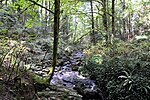Lake Oswego Railroad Bridge
1910 establishments in OregonBridges completed in 1910Bridges in Clackamas County, OregonBridges over the Willamette RiverLake Oswego, Oregon ... and 5 more
Metal bridges in the United StatesRailroad bridges in OregonSouthern Pacific RailroadTruss bridges in the United StatesUnion Pacific Railroad bridges

The Lake Oswego Railroad Bridge (also known as the Union Pacific Railroad Bridge at Lake Oswego and formerly as the Southern Pacific Railroad Bridge at Lake Oswego) is a truss railroad bridge that spans the Willamette River between Lake Oswego, Oregon and Oak Grove, Oregon. Owned by the Union Pacific Railroad, it is currently leased by the Portland and Western Railroad and carries the Milwaukie branch.
Excerpt from the Wikipedia article Lake Oswego Railroad Bridge (License: CC BY-SA 3.0, Authors, Images).Lake Oswego Railroad Bridge
Southeast Fairoaks Drive,
Geographical coordinates (GPS) Address External links Nearby Places Show on map
Geographical coordinates (GPS)
| Latitude | Longitude |
|---|---|
| N 45.4251 ° | E -122.6547 ° |
Address
Lake Oswego Railroad Bridge
Southeast Fairoaks Drive
97036
Oregon, United States
Open on Google Maps









